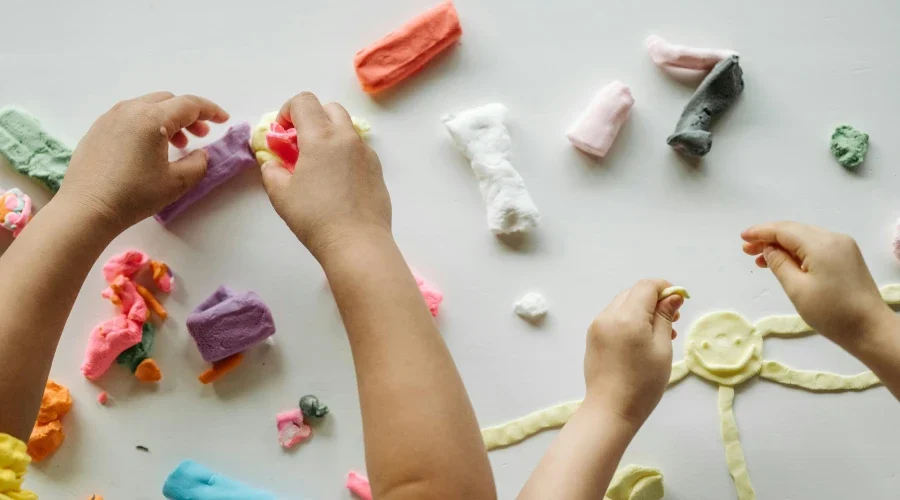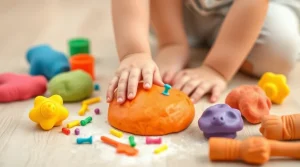
What Is Sensory Education in Montessori?
A complete guide to Montessori sensory education—how it refines perception, builds focus, and supports early development.
#1 Toys Manufacturer in China. WhatsApp: +86 180-0088-4063. Email: [email protected]
#1 Toys Manufacturer in China. WhatsApp: +86 180-0088-4063. Email: [email protected]

Sensory toys aren’t just fun – they help kids learn and grow! Want to know why playdough, kinetic sand, and slime are so powerful?
Sensory toys have been quietly revolutionizing the way kids play and learn. They’re not just about fun, though that’s a big part of it. These toys — from squishy playdough to stretchy slime, soft air-dry clay, moldable kinetic sand, and pliable modeling clay — are designed to engage children’s senses in ways that foster creativity, learning, and even emotional regulation.
Let’s look at it through a simple story. Imagine a child sitting at a table, fidgeting with a lump of playdough. With just a few squishes, rolls, and pokes, they’re suddenly creating a tiny creature or shaping a landscape of mountains.
That’s the magic of sensory toys — they let kids explore the world through touch and play. And whether it’s the silky feel of kinetic sand or the resistance of air-dry clay, these materials are all about making sense of the world in a tactile way.
According to the American Academy of Pediatrics, sensory play is crucial for child development. It helps with everything from motor skills to social interaction, laying a foundation for future learning in subtle but important ways.
As sensory experiences become a vital part of early childhood education, toys like playdough, slime, and clay are stepping into the spotlight. They are more than just toys, they are the tools for building brighter, more creative minds.
Sensory toys like playdough, slime, and kinetic sand offer more than just fun. They help children develop cognitive skills, improve fine motor abilities, regulate emotions, and spark creativity. Plus, they promote social interaction and collaborative play!
Imagine a child using kinetic sand to build a tower. They quickly learn that the sand won’t hold its shape unless they figure out a better way to mold it. Each time they reshape it, their brain is learning how to plan, test, and adjust.
The same happens with playdough — when they roll it into shapes or try to form letters, they’re not just playing; they’re learning to think ahead and adapt.
Manipulating materials like slime, modeling clay, or playdough does more than keep kids entertained. It also strengthens their hands and fingers.
When a child rolls clay into a ball or squeezes slime, they’re working on hand coordination and finger strength. These simple actions prepare them for tasks like holding a pencil, tying shoes, or even playing an instrument. It’s like an invisible workout for their hands — and the best part is, they don’t even realize they’re practicing something important.
For many kids, sensory toys are a calming tool. Playing with slime, for example, can help them focus on the texture and movement, which allows them to process emotions or release tension. Children who struggle with sensory overload can benefit from squeezing kinetic sand or pressing into modeling clay, providing a physical outlet that helps them feel more in control.
According to the American Occupational Therapy Association, sensory toys like these can help regulate mood and calm anxiety by offering a soothing tactile experience.
Sensory toys are also a gateway to endless creativity. With a little bit of playdough or air-dry clay, a child can create anything from dinosaurs to spaceships.
These materials don’t come with rules or limits — they’re simply there to be molded, stretched, and shaped into whatever the child imagines. Maybe they start by forming a ball but soon turn it into a miniature animal. This kind of open-ended play is a powerful way to fuel creativity, allowing kids to tell stories, create characters, and even act out scenarios.
Though sensory toys can be enjoyed alone, they’re also great for group play.
Imagine a group of kids working together to build a sandcastle out of kinetic sand. They’re not just building a structure; they’re learning to cooperate, share ideas, and work as a team. The same goes for activities like making group art with playdough. These toys provide a low-pressure way for children to interact, communicate, and learn social skills without realizing they’re doing so.
Plus, when kids create something together, they take pride in their shared accomplishment.
From squishy playdough to stretchy slime and moldable kinetic sand, let’s find out what makes each one special and super fun for kids to play with!
Playdough is a classic sensory toy that kids love. It’s soft, squishy, and easy to mold, making it perfect for little hands. Children can create endless shapes, objects, or even tiny sculptures, which helps them develop creativity and problem-solving skills. Playdough is also a great tool for teaching basic motor skills, as kids can roll, flatten, and squeeze it into different forms.
As a versatile sensory toy, playdough comes in a variety of colors, textures, and even scents. This makes it even more engaging for kids, as they can mix and match to create new combinations. For those interested in wholesale playdough, customization options like unique colors or scented varieties are available, perfect for kindergarten.
>> Top 5 Playdough Sets for Creative Play
Air-dry clay offers something a little different from playdough. It’s smoother, a bit firmer, and, as the name suggests, hardens when exposed to air. This makes it ideal for art projects where kids want their creations to last, whether they’re crafting small animals, jewelry, or decorative items.
Unlike other clays, air-dry clay doesn’t require baking or any special tools — just shape it, let it sit, and it will dry on its own. It’s also non-toxic and mess-free, making it a favorite among parents and teachers. Schools often appreciate its low-maintenance, especially when ordering in bulk for class art projects.
>> Lightweight Air Dry Clay Toys
Slime has taken the sensory world by storm. Its gooey, stretchy texture offers a completely different experience compared to other toys. Kids love the way it moves, stretches, and squishes between their fingers. Beyond the fun, slime is a fantastic tool for sensory play, helping children focus on touch and movement while calming restless minds.
For those looking to order slime in bulk, it’s highly customizable. You can add glitter, change colors, or even introduce scents. This makes it popular for schools, parties, or retail, where kids can enjoy personalized slime creations.
>> Lastest Slime Toys for Kids
Kinetic sand feels like regular sand, but it sticks together, making it easier to mold and shape without the mess. Its unique formula allows it to be both soft and moldable, yet clean and reusable. Kids can spend hours building castles, animals, or just letting the sand flow through their fingers.
Kinetic sand is perfect for sensory stimulation, especially for children who enjoy tactile play. And the best part? It doesn’t dry out or make a mess. For larger orders, bulk kinetic sand is available in different colors and textures, making it a flexible option for schools, therapy centers, and toy stores.
Sensory toys offer special benefits for kids with ASD, ADHD, and SPD. They help with calming, focus, and sensory exploration in fun, engaging ways.
For children with Autism Spectrum Disorder (ASD), sensory toys can provide much-needed calming effects. The soft texture of kinetic sand or the stretchiness of slime can help children self-regulate by providing repetitive, soothing movements.
Many therapists use playdough and modeling clay in sessions with kids on the spectrum. These toys allow children to engage in tactile sensory stimulation, which can ease anxiety and help them focus on the moment. A simple act like squishing playdough between their fingers can make a big difference in how they process their environment.
Children with ADHD often struggle to stay focused, especially during tasks that require sitting still. Sensory toys like slime or kinetic sand can be great fidget tools, giving them something to manipulate with their hands while they concentrate on schoolwork or therapy. The squishy texture of slime is especially good for keeping restless hands busy.
By providing a calming, soothing outlet, these toys help reduce restlessness and allow children to direct their energy in a more focused way. Kids can press, stretch, or mold the slime as they take on tasks that require focus.
For children with Sensory Processing Disorder (SPD), sensory toys can be an important part of therapy. Playdough, modeling clay, and air-dry clay offer different textures that can help kids explore and tolerate new sensations. These soft, moldable toys are often used to introduce textures gradually, helping children with SPD get used to different feelings on their hands.
Kinetic sand is especially useful for this — its unique texture falls somewhere between solid and liquid, offering just the right level of stimulation for kids who may be overwhelmed by harsher sensations. It’s a gentle way to build sensory tolerance over time.
Age and interest are important when choosing sensory toys for kids. For example, a toddler may like soft play dough, while a preschooler may prefer kinetic sand. Understand children’s tactile preferences and find the best toy!
Selecting the right sensory toy can depend on children’s age and developmental stage. For toddlers, playdough is an excellent choice. Its soft, pliable nature is perfect for little hands. Toddlers can easily squish, roll, and mold playdough, enhancing their fine motor skills.
As children grow into preschoolers, kinetic sand becomes a suitable option. It’s slightly less sticky than playdough and can be shaped with minimal effort. This type of sand is engaging and helps children practice hand-eye coordination while having fun.
Older children often enjoy slime. Its unique texture offers a stimulating, interactive experience. Slime comes in various colors and can be stretched or squashed, sparking creativity and providing a tactile challenge.
When choosing sensory toys, consider the child’s texture preferences. Some children prefer smooth and soft textures like those found in air-dry clay, while others might enjoy the gritty feel of kinetic sand. If the child is sensitive to certain textures, start with options that align with their comfort level.
Customization can also play a role. For example, sensory toys can be tailored with different textures, colors, and even scents to meet individual needs. Bulk orders of playdough or slime can be customized to match these preferences, offering a variety of options for educational and therapeutic uses.
Buying sensory toys in bulk can save schools, therapists, and retailers a lot of money. Plus, you can customize items like playdough or slime with your branding.
Purchasing sensory toys in bulk, such as playdough, air-dry clay, slime, and kinetic sand, offers significant cost savings. Schools, therapists, and retailers can take advantage of reduced prices when buying in larger quantities. This is particularly useful for those who need to equip multiple classrooms or therapy sessions without breaking the budget.
Bulk orders also simplify inventory management. Educational institutions and therapy centers often require consistent supplies. Buying wholesale ensures that these needs are met reliably, while also providing an opportunity to stock up on sensory toys that can be used in various activities.
Customizing sensory toys is another key benefit. Schools and therapy centers can order branded playdough, slime, or modeling clay, which helps in creating a unique identity for their programs. Custom sets can be tailored to include specific colors or textures, enhancing their educational value or therapeutic effectiveness.
For retailers and institutions, offering branded sensory toy kits can boost visibility and engagement. Customization can include everything from logo placement on the toys to personalized packaging, making these products stand out in a crowded market and aligning them with specific educational or therapeutic goals.
Looking for top-notch sensory toys? We’ve got you covered with safe, high-quality materials and custom options. Plus, our bulk pricing and friendly support make it easy to get what you need.
Our commitment to safety is paramount. We use non-toxic, child-safe materials in all our sensory toys, including playdough, slime, and kinetic sand. Each product adheres to stringent safety standards, ensuring they are safe for use in educational and therapeutic settings.
We also prioritize environmental responsibility. Many of our products, like air-dry clay and kinetic sand, are crafted with eco-friendly practices in mind. This approach helps reduce our environmental impact while providing high-quality, safe toys.
We offer extensive customization options for bulk orders of sensory toys. Whether you need custom colors for playdough, unique scents for slime, or personalized packaging for air-dry clay, we can accommodate your needs. Our flexibility extends to order sizes, making it easy to get exactly what you need, from small batches to large quantities.
We pride ourselves on offering competitive pricing for bulk orders of sensory toys. Our goal is to make high-quality, customizable products accessible at a reasonable cost. Additionally, our customer support team is dedicated to assisting with any queries or special requirements, ensuring a smooth and satisfactory purchasing experience.
Sensory toys like playdough, slime, and kinetic sand offer endless benefits for various settings. By choosing to buy in bulk, you can save money, enjoy customization options, and ensure high quality and safety. Whether for educational purposes, therapy sessions, or retail, finding the right supplier makes all the difference.
Contact us today to inquire about wholesale sensory toys, customized options, and bulk pricing!
Sensory toys are designed to stimulate the senses—touch, sight, sound, and sometimes smell. For toddlers, these toys often help in developing fine motor skills and hand-eye coordination. Preschoolers might benefit from toys that promote creative play and cognitive development. Older children can use more complex sensory toys to enhance their problem-solving skills and creativity. These toys can also support therapeutic practices by addressing sensory processing needs across various age groups.
Yes, children with sensory processing disorders often benefit from toys that cater to their specific sensory needs. For instance, tactile toys like textured playdough or kinetic sand can help with tactile sensitivity. Fidget toys and weighted items can assist with sensory regulation and focus. It’s best to select toys that align with the child’s sensory preferences and sensitivities, and consulting with an occupational therapist can provide tailored recommendations.
Educators can integrate sensory toys into classroom activities by using them to support learning and development. For example, playdough can be used in art projects to enhance creativity and fine motor skills. Kinetic sand can be used for sensory bins to explore concepts like texture and volume. Sensory toys can also be employed during quiet time or as rewards to help students focus and manage stress, making them versatile tools in the educational environment.
Sensory toys should meet stringent safety standards to ensure they are non-toxic and safe for children. Look for products that comply with ASTM (American Society for Testing and Materials) or EN71 (European Standard) regulations, which cover toy safety. Manufacturers should provide certifications and safety test reports. Additionally, ensure that the toys are free from choking hazards and are made from materials that are safe for children to handle.
Yes, sensory toys can be highly effective in therapy sessions, particularly for children with developmental delays or sensory processing issues. When choosing sensory toys for therapy, consider the specific goals of the session. Toys should be selected based on the sensory needs of the individual—such as tactile stimulation, visual engagement, or auditory feedback. Consulting with a therapist can help in selecting the most appropriate toys to support therapeutic goals and address individual sensory needs.
More Related...

A complete guide to Montessori sensory education—how it refines perception, builds focus, and supports early development.

Educational toys unlock creativity, problem-solving, and sensory skills—find out why they matter for every growing child.

From calming stress to building skills, see how sensory toys help children develop focus, creativity, and confidence through hands-on play.

What’s the best toy for child development? Learn how sensory toys shape young minds and bodies in early learning stages.

Our team will answer your inquiries within 48 hours.
Copyright © 2025 GuangDong AKIA Technology Co,. Ltd. All Rights Reserved